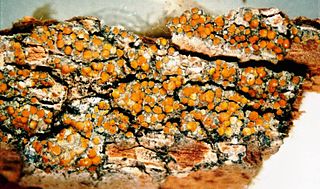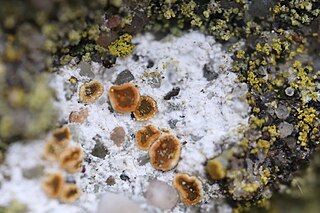
The Teloschistaceae are a large family of mostly lichen-forming fungi belonging to the class Lecanoromycetes in the division Ascomycota. The family has a cosmopolitan distribution, although members occur predominantly in subtropical and temperate regions. Most members are lichens that either live on rock or on bark, but about 40 species are lichenicolous – meaning they are non-lichenised fungi that live on other lichens. Many members of the Teloschistaceae are readily identifiable by their vibrant orange to yellow hue, a result of their frequent anthraquinone content. The presence of these anthraquinone pigments, which confer protection from ultraviolet light, enabled this group to expand from shaded forest habitats to harsher environmental conditions of sunny and arid ecosystems during the Late Cretaceous.

Gyalolechia is a genus of lichen-forming fungi belonging to the family Teloschistaceae. It contains 18 species of crustose lichens.

Calogaya is a genus of lichen-forming fungi belonging to the family Teloschistaceae. It has 19 species. The genus was circumscribed in 2013 by Ulf Arup, Ulrik Søchting, and Patrik Frödén. The generic name Calogaya honours Dr. Ester Gaya, a Spanish botanist from the University of Barcelona.

Flavoplaca is a genus of crust-like or scaly lichens in the family Teloschistaceae. It has 28 species with a mostly Northern Hemisphere distribution.

Xanthocarpia is a genus of mostly crustose lichens in the family Teloschistaceae. It has 12 species with a largely Northern Hemisphere distribution.

Polycauliona is a genus of lichen-forming fungi in the family Teloschistaceae.

Squamulea is a genus of lichen-forming fungi in the family Teloschistaceae. It has 15 species. The genus was circumscribed in 2013 by Ulf Arup, Ulrik Søchting, and Patrik Frödén, with Squamulea subsoluta assigned as the type species. Five species were included in the original account of the genus. The genus name alludes to the squamulose growth form of most of its species. Squamulea has a worldwide distribution; when the genus was originally created, the centre of distribution was thought to be in southwestern North America.

Cerothallia is a genus of crustose lichens in the family Teloschistaceae. It has four species, all of which occur in the Southern Hemisphere. The genus was circumscribed in 2013 by Ulf Arup, Patrik Frödén, and Ulrik Søchting, with Cerothallia luteoalba assigned as the type species. The type is more widely distributed, as it is also found in Europe and North America. The generic name Cerothallia means "with waxy thallus".
Sirenophila is a genus of crustose lichens in the subfamily Teloschistoideae of the family Teloschistaceae. It has four species with an Australasian distribution.

Kuettlingeria is a genus of saxicolous (rock-dwelling), crustose lichens in the family Teloschistaceae. Species are characterized by a white or gray thallus and the presence of anthraquinones in the apothecial disc and true exciple, with the exception of Kuettlingeria diphyodes, which entirely lacks anthraquinones. First described by Italian botanist Trevisan in 1857, the genus includes 15 recognized species, although it is believed to be more diverse with additional unnamed species. These lichens are predominantly found in the Northern Hemisphere, particularly in the Mediterranean region, and grow on limestone and base-rich siliceous outcrops in sunlit conditions.

Wetmoreana is a genus of lichen-forming fungi in the family Teloschistaceae. It has two crustose, saxicolous (rock-dwelling) species.
Sanguineodiscus is a genus of lichen-forming fungi in the family Teloschistaceae. It is characterized by its deep red apothecial discs, found predominantly in the Mediterranean basin, Central Asia, Northern Africa, and Europe. This genus comprises both saxicolous and corticolous species, which are found in various habitats, such as inland rain-sheltered base-rich siliceous rocks, seashore siliceous rocks, and calcareous outcrops in Central Asia. Sanguineodiscus, established in 2023, contains four recognized species, but it is believed that the genus contains more unnamed taxa.
Tassiloa is a genus of lichen-forming fungi in the family Teloschistaceae. It has two species.
Orientophila is a genus of lichen-forming fungi in the family Teloschistaceae. It has 15 species of mostly saxicolous (rock-dwelling), crustose lichens. All Orientophila species occur in Northeast Asia including China, Japan, South Korea, and the Russian Far East.
Elixjohnia gallowayi is a species of saxicolous (rock-dwelling), crustose lichen in the family Teloschistaceae. It has a vividly coloured thallus, ranging in hues from bright red to reddish-orange. It is found in Australia.
Caloplaca sterilis is a corticolous (bark-dwelling), crustose lichen belonging to the family Teloschistaceae, described in 2011. It is primarily found in steppe and sand dune habitats in the Black Sea region, and has been recorded from Bulgaria, Romania, southwest Russia, and Ukraine. Caloplaca sterilis is characterised by tiny squamules/areoles with contrasting pale greyish-green to greenish soredia. It is easily overlooked and challenging to identify when completely sorediate and sterile, especially as its soredia do not contain the typical Sedifolia-grey pigment.
Pyrenodesmia micromarina is a species of saxicolous (rock-dwelling), crustose lichen in the family Teloschistaceae. It is found in the Eastern Mediterranean, specifically along the coasts of the Black Sea and the Sea of Marmara in Russia, Turkey, and Ukraine. It grows on coastal rocks and occasionally concrete, often in Mediterranean scrub vegetation.
Dufourea angustata is a species of saxicolous (rock-dwelling), crustose lichen in the family Teloschistaceae. It is widely distributed across Australia.
Kuettlingeria soralifera is a saxicolous (rock-dwelling), crustose lichen species in the family Teloschistaceae, first described in 2006. It is similar to Kuettlingeria xerica but distinguished by the presence of soredia on its thallus.










